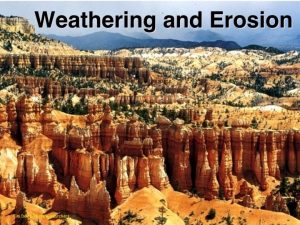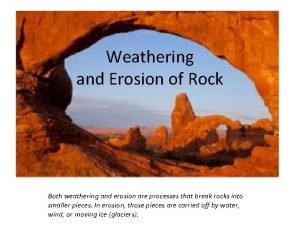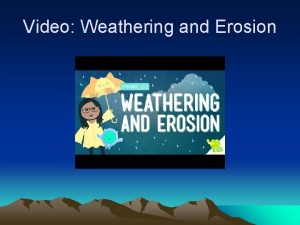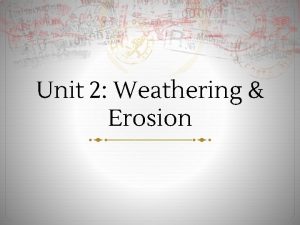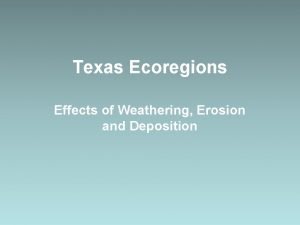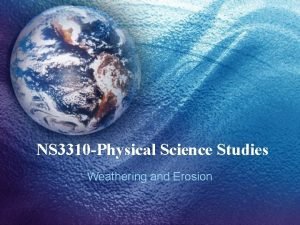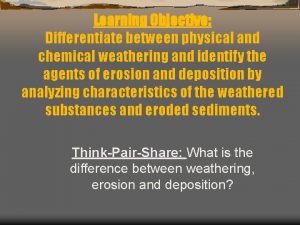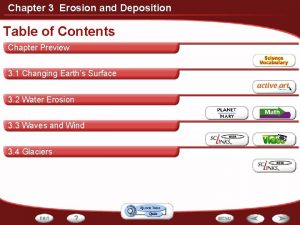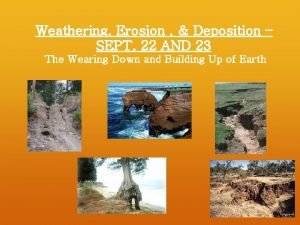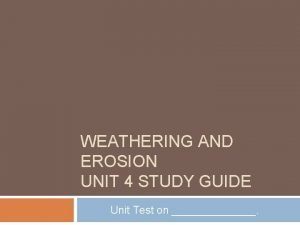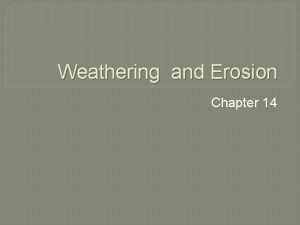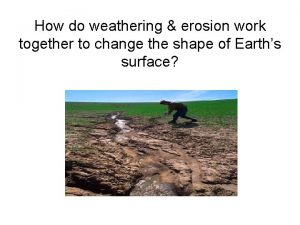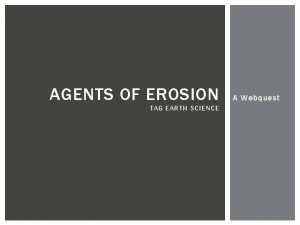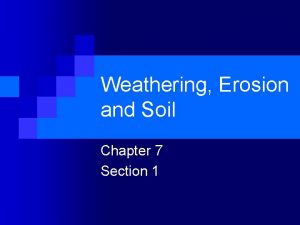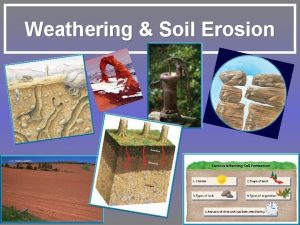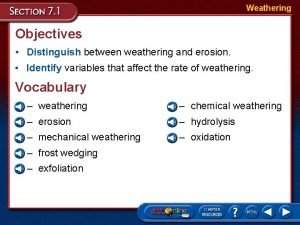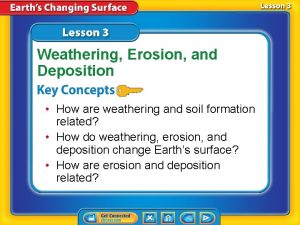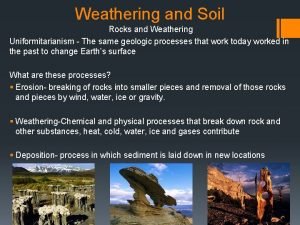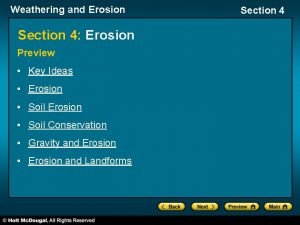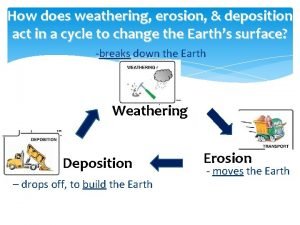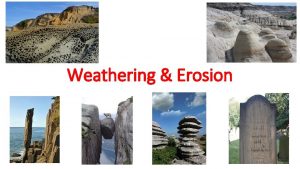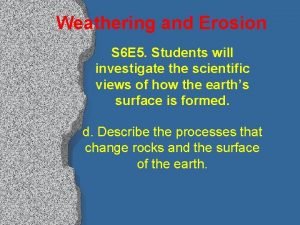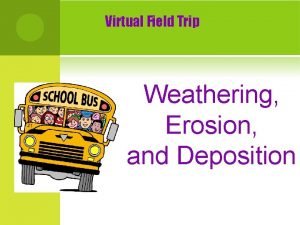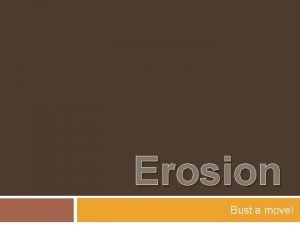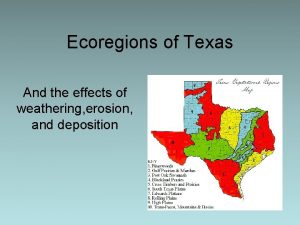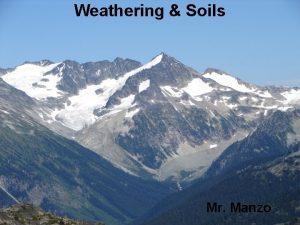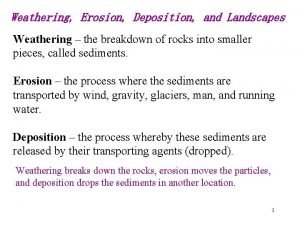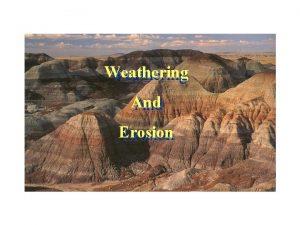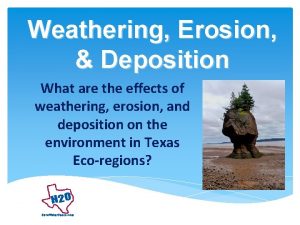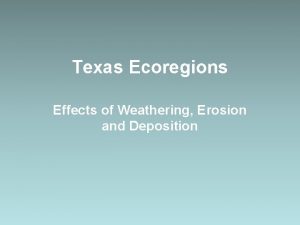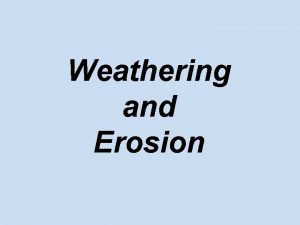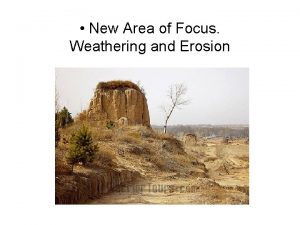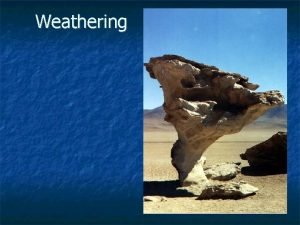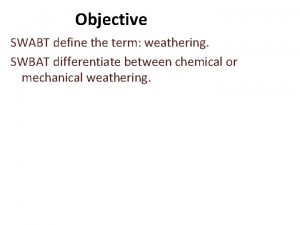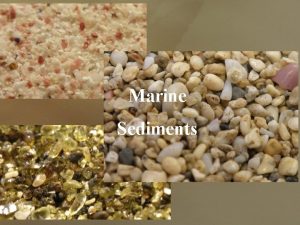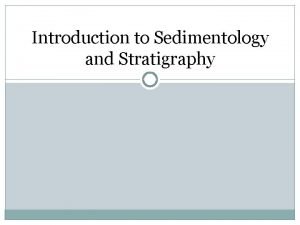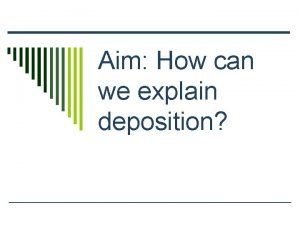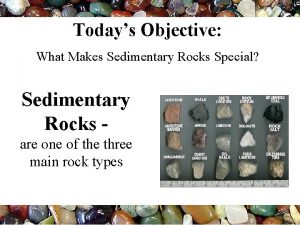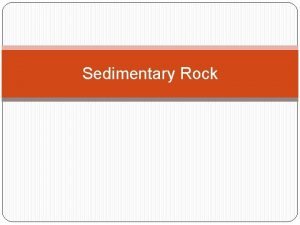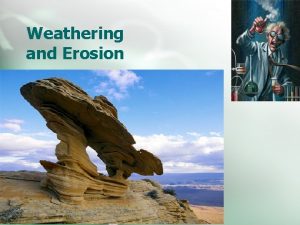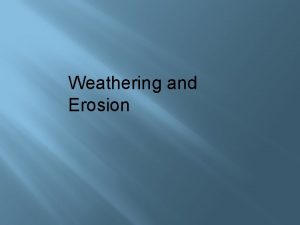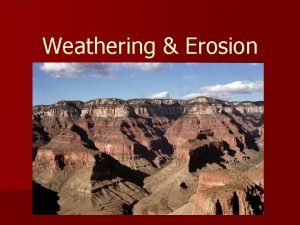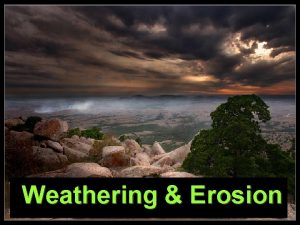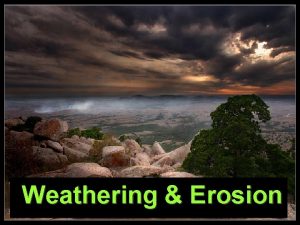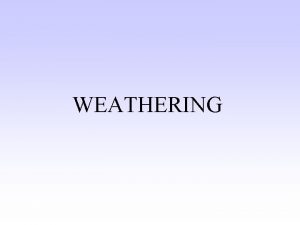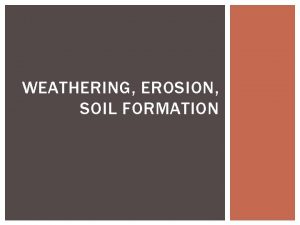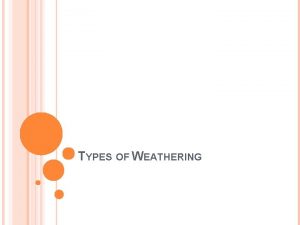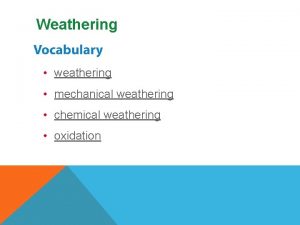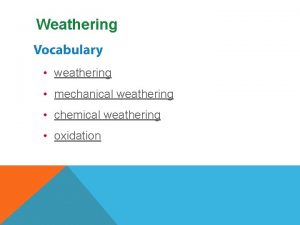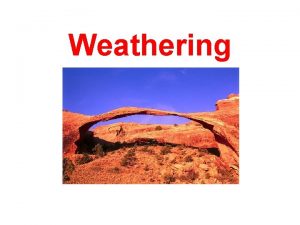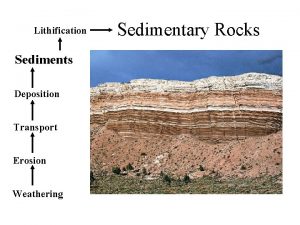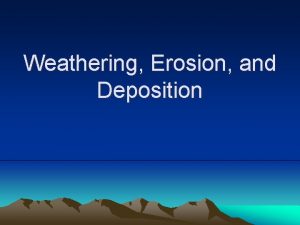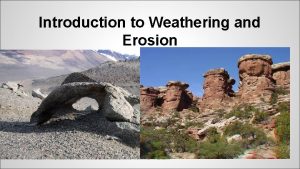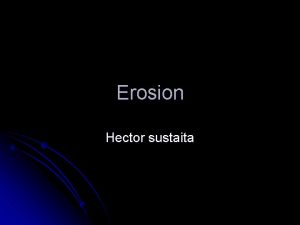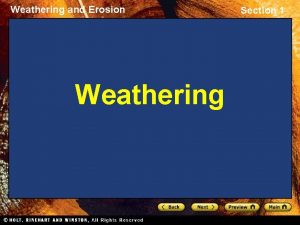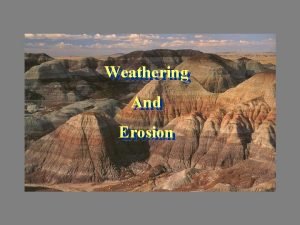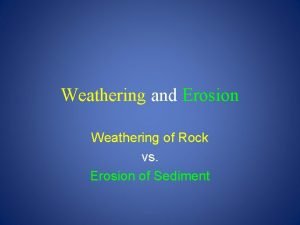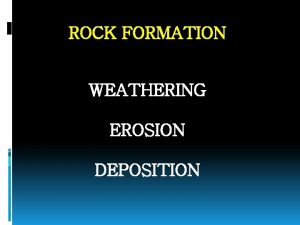Weathering and Erosion Weathering of Rocks Sediments are


















































- Slides: 50

Weathering and Erosion

Weathering of Rocks Sediments are the end products of weathering Mechanical – the physical breaking apart of Earth materials Chemical – alters the internal structure of minerals by removing and/or adding elements

Weathering of Rocks Mechanical weathering Frost wedging Unloading Biological activity

Weathering of Rocks Chemical weathering Water is the most important agent Reactions such as oxidation or dissolution by acids serve to decompose rocks Clay minerals are the most abundant and stable product of chemical weathering


Weathering Two kinds of weathering Chemical weathering • Weathering of granite s potassium feldspar s clay minerals + soluble salt + silica in solution s Quartz remains substantially unaltered s Weathering of silicate minerals produces insoluble iron oxides and clay minerals

Rates of weathering Important factors Rock characteristics • Mineral composition and solubility • Physical features such as joints Climate • Temperature and moisture are the most crucial factors • Chemical weathering is most effective in areas of warm temperatures and abundant moisture

Weathering Products Soil Sediments

Soil An interface in the Earth system Soil is a combination of mineral matter, water, and air – that portion of the regolith that supports the growth of plants

Soil texture and structure Texture refers to the proportions of different particle sizes • Sand (large size) • Silt • Clay (small size) Loam (a mixture of all three sizes) is best suited for plant life

Soil texture and structure Structure • Soil particles clump together to give a soil its structure • Four basic soil structures s s Platy Prismatic Blocky Spheroidal

Soil Controls of soil formation Parent material • Residual soil • Transported soil Time Climate Plants and animals

Soil Controls of soil formation Slope • Angle s Steep slopes = poorly developed soils • Orientation (direction the slope is facing) influences s Soil temperature s Moisture

Soil Profile Soil forming processes operate from the surface downward Horizons – zones or layers of soil

Soil Profile

Soil Types

Soil erosion Recycling of Earth materials Natural rates of erosion depend on • • Soil characteristics Climate Slope Type of vegetation

Soil erosion and sedimentation cause • Reservoirs to fill with sediment • Contamination by pesticides and fertilizers

Weathering creates ore deposits Process called secondary enrichment Concentrates metals into economical deposits Takes place in one of two ways • Removing undesired material from the decomposing rock, leaving the desired elements behind • Desired elements are carried to lower zones and deposited

Weathering creates ore deposits Examples Bauxite, the principal ore of aluminum Many copper and silver deposits

Erosion “The wearing away of bedrock and transport of loosened particles by a fluid, such as water. ” How is this different from weathering? Weathering occurs in place Both can occur at the same time

Water (Source) Wind (Source) Sources of Erosion Ice (Source)

Erosion via Water Streambed sediments = Alluvium

How Streams Move Sediment

Erosion via Wind

Erosion via Ice Plucking Abrasion

Mass Wasting What is mass wasting? The downslope movement of rock, regolith, and soil under the direct influence of gravity.

Mass Wasting Location, Location Occur in every state and U. S. territory. Nearly all occur in mountainous regions Weak or fractured materials + steep slope = landslides.

Landslide Areas in the Contiguous United States. Areas in color areas of high to moderate incidence of landslides, plus areas of moderate incidence but high susceptibility to landsliding. Incidence of land slides is high when greater than 15% of the area is actually part of a landslide or other ground failure. Moderate incidence means that 1. 5 to

Map showing where landslides are likely to occur in the southwestern United States. Note that the areas with the highest rate of landslide incidents are located in mountainous terrain

The Origins of Mass Wasting Gravity Other Factors: Water Steep Slopes Vegetation Geology Earthquakes

The Origins of Mass Wasting Water Triggered when water builds up in the slope • heavy rains • snowmelt • poor drainage.

Causes Of Mass Wasting Water (continued) First, water > the weight and < the strength of the material in the slope. Pore pressure in the slope >, and clay minerals become hydrated and expand. Minerals holding individual grains together may dissolve.

Causes Of Mass Wasting Steep Slopes Gravitational forces >> strength of the rock or soils = Slope failure Occurs when • Slope is over steepened • A heavy load is placed at the top of the slope • Removing material at the base of the slope.

Causes Of Mass Wasting Vegetation The type of vegetation present (or not) Removal of vegetation Reseeding or replanting slopes

Causes Of Mass Wasting Geology Adverse Geological Structure • Bedding surfaces of weak rocks dip downslope and are unsupported at the lower end • Similar problems with faults, joints, foliation etc

Causes Of Mass Wasting Earthquakes, or any other type of strong vibrations, can trigger landsides on slopes which are already unstable.

Causes Of Mass Wasting Human caused Landslides Cut slopes produce removal of hill support and failure occurs Uncontrolled fills may settle, erode, slough away or slip in mass

Causes Of Mass Wasting Human caused Landslides (continued) Four ways to make a stable slope unstable • • Steepen slope angle Increase the height of the slope Saturate with water Place an extra load on the slope

Types of Mass Wasting Classified by Type Material Rate of movement

Types of Mass Wasting Type Slide: movement parallel to planes of weakness and slope. • Rotational: complex movement of materials on a slope • Translational or Block: beds move as one unit Creep: gradual movement of slope materials Topple: the end over end motion of rock down a slope. Fall: material free falls Flow: viscous to fluid like motion of debris. Torrent: a sporadic and sudden channelized discharge of water and debris

Types of Mass Wasting

Types of Mass Wasting Type Slides Rotational landslides • Occur in homogeneous material • Curved slide plane

Types of Mass Wasting Type Slides (continued) Translational landslide • Typically occurs along a planar surface • Common in S. California in Miocene aged Formations • Puente, Topanga, Monterey, etc.

La Conchita, California. This landslide and debris flow occurred in the spring of 1995. Many people were evacuated because of the slide and the houses nearest the slide were completely destroyed. Fortunately, no one was killed or injured.


Huge boulder transported by a debris flow produced during an intense, short duration summer rain "cloud burst" in the Barton Flats area of the San Bernardino Mountains, in the 1960 s.

Types of Mass Wasting Material Debris, mud, earth, rock Table 1 summarizes one way of naming slope-failure deposits and their associated slope

Types of Mass Wasting Rate of Movement Fast • • Slumps Rockslides Debris flows Earthflows Slow • Creep • Solifluction

end
 Antigentest åre
Antigentest åre Sedimentary rock song
Sedimentary rock song Igneous metamorphic and sedimentary
Igneous metamorphic and sedimentary Chad lentz
Chad lentz Erosion in the piney woods
Erosion in the piney woods What is the difference between weathering and erosion?
What is the difference between weathering and erosion? Rain washing away soil from a hillside
Rain washing away soil from a hillside Erosion video bill nye
Erosion video bill nye Hydrolysis
Hydrolysis Weathering and erosion difference youtube video
Weathering and erosion difference youtube video Questions on weathering and erosion
Questions on weathering and erosion Post oak woods and prairies weathering
Post oak woods and prairies weathering Piney woods erosion
Piney woods erosion Get5gets
Get5gets Differentiate between chemical and physical weathering.
Differentiate between chemical and physical weathering. Weathering erosion and deposition
Weathering erosion and deposition Weathering and erosion
Weathering and erosion Weathering and erosion study guide
Weathering and erosion study guide Chapter 14 weathering and erosion review answers
Chapter 14 weathering and erosion review answers What happens when weathering and erosion work together?
What happens when weathering and erosion work together? Weathering and erosion webquest
Weathering and erosion webquest Chapter 7 weathering erosion and soil
Chapter 7 weathering erosion and soil Soils in ____ contain little organic material and are thin.
Soils in ____ contain little organic material and are thin. Distinguish between weathering and erosion
Distinguish between weathering and erosion Weathering and soil erosion
Weathering and soil erosion Uniformitarianism examples
Uniformitarianism examples Weathering and soil erosion
Weathering and soil erosion Weathering erosion and deposition
Weathering erosion and deposition Weathering and erosion
Weathering and erosion Agents of weathering
Agents of weathering What is deposition? *
What is deposition? * Weathering vs erosion
Weathering vs erosion Piney woods texas ecoregions
Piney woods texas ecoregions Erosion and weathering
Erosion and weathering Sedimentary weathering
Sedimentary weathering Extrusive igneous rocks
Extrusive igneous rocks Granite diorite gabbro
Granite diorite gabbro Agents of erosion
Agents of erosion Weathering vs erosion
Weathering vs erosion Mechanical and chemical weathering venn diagram
Mechanical and chemical weathering venn diagram Trans pecos weathering
Trans pecos weathering Weathering vs erosion
Weathering vs erosion Weathering vs erosion
Weathering vs erosion Mechanical and chemical weathering examples
Mechanical and chemical weathering examples Physical weathering and chemical weathering venn diagram
Physical weathering and chemical weathering venn diagram Classification of marine sediments
Classification of marine sediments What are sedimenta
What are sedimenta A low hill is composed of unsorted sediments
A low hill is composed of unsorted sediments A process that squeezes or compacts sediments
A process that squeezes or compacts sediments Sedimentary rock
Sedimentary rock A process that squeezes, or compacts, sediments
A process that squeezes, or compacts, sediments





